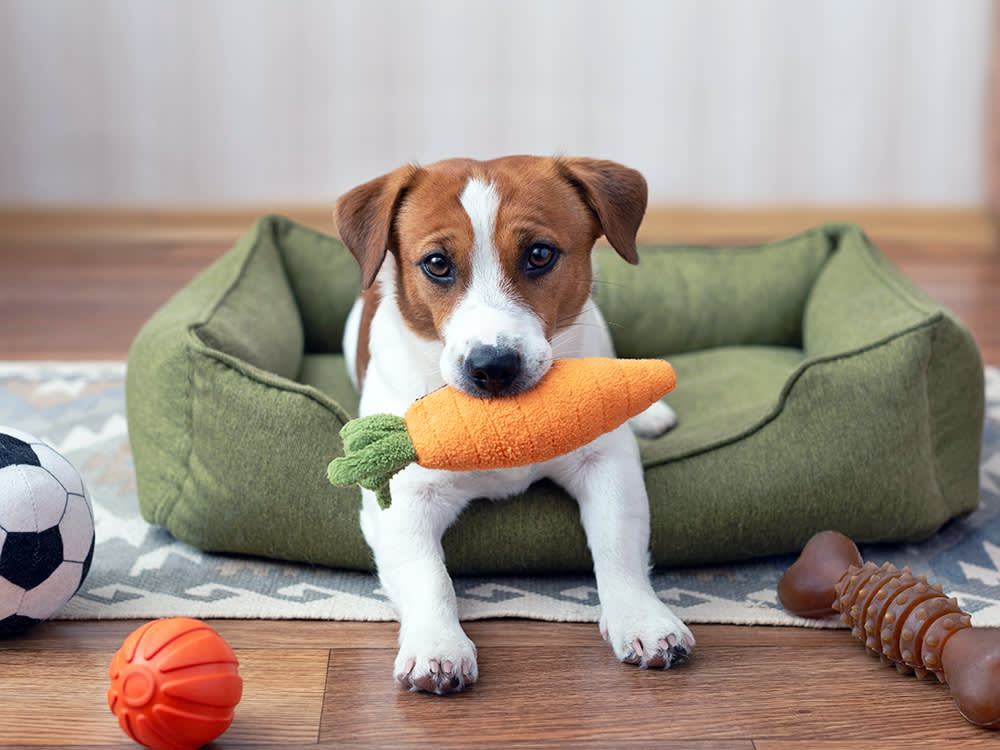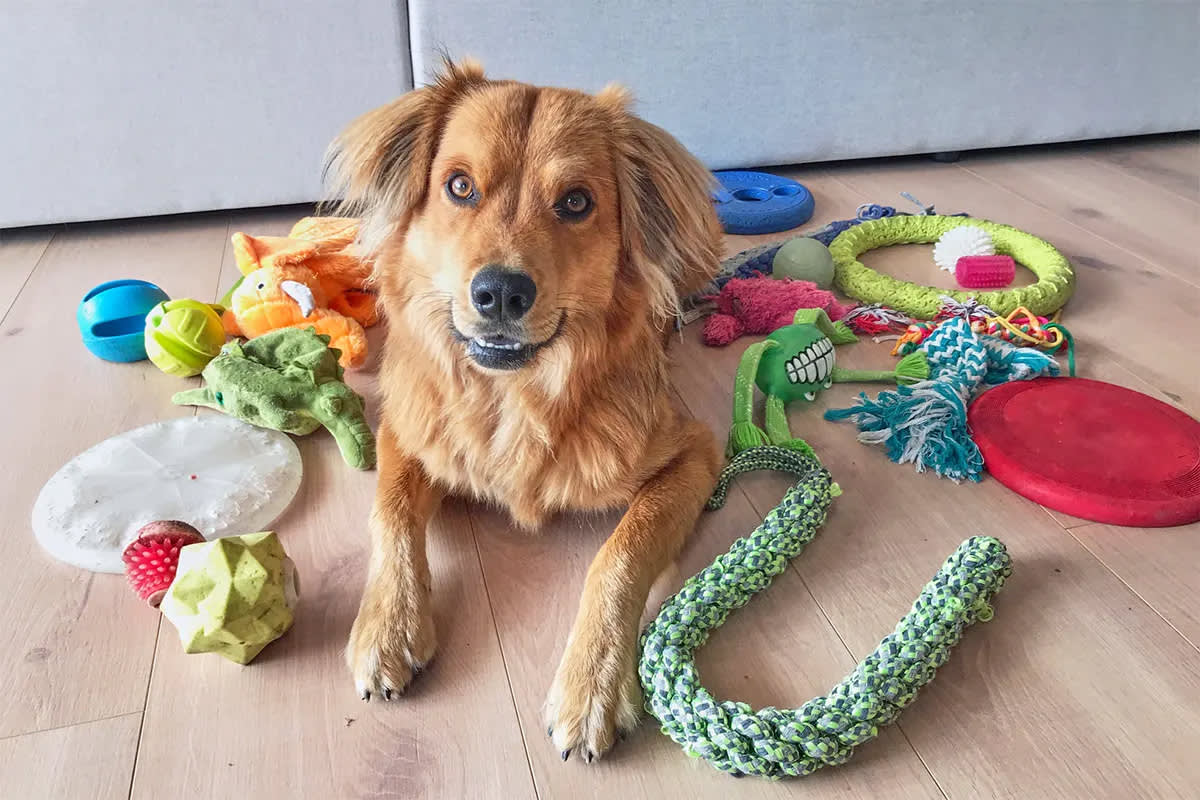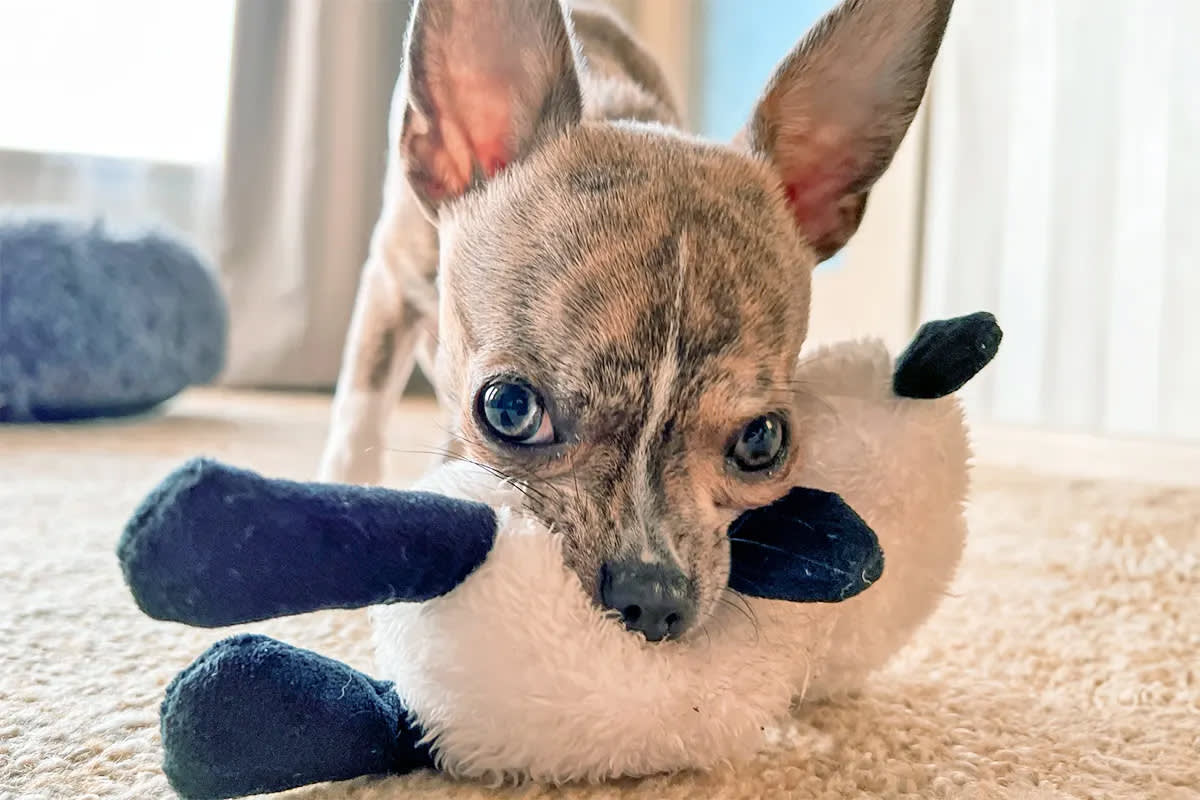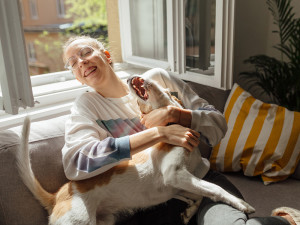Why Your Dog is Such a Hoarder
Some breeds certainly seem to, uh, collect things more than others.

Share Article
Obsessed with Labubus or antique teacups? Do you hoard old matchbooks or keep your stash of rare books neatly arranged on the mantel? This Golden Retriever understandsopens in new tab, and he’s learned to fit all his favorite toys in his mouth so that they’re never far. This little Frenchieopens in new tab has collected all his toys on the bed and just dares you to try and move one — he’s got eyes in the back of his head. And this little angelopens in new tab, who’d previously been a stray, collects everything he’s given and puts it in his crate. Smart boy.
But these pups aren’t the only ones who tend to hoard things. Recently, this Goldenopens in new tab has become so well-known for stealing his parents’ items that he’s become internetopens in new tab famousopens in new tab.
So, why do dogs hoard their toys, treats... or even their pet parents’ stuff? And are certain breeds more likely to do it? For Dr. Sabrina Kongopens in new tab, the staff veterinarian at We Love Doodles, toy hoarding is all too familiar. Her dog, a Doodle named Benny, is what she calls a “classic hoarder.”
“His prized stash, always kept in his bed, consists of his favorite plush toys and, quite oddly, my fluffiest socks,” Dr. Kong says. “He doesn't just leave them in a pile, but he very deliberately carries each item over in his mouth.” Benny often makes a special trip after a walk or meal to “check” on his collection, she adds. Here’s a look at why dogs like Benny do what they do.
How much do you spend on your pet per year?

Why do dogs hoard toys?
There haven’t been any studies about why dogs might choose to gather all their toys and hoard them like Scrooge McDuck presiding over a pile of gold. And, while most dogs are undeniably fond of their toys or treats, hoarding is not a super common behavior in the first place, says Dr. Katherine Houptopens in new tab, a veterinary behaviorist and professor emeritus at the Cornell University College of Veterinary Medicine.
But experts do have theories as to why your dog might suddenly decide to line up all their Lamb Chops.
Theory 1: Your pup is compensating for a challenging past.
In many cases, pet parents may not be aware of their dog’s history before they were rescued or adopted. But if your dog is a rescue pup who once may have had to compete for resources before they were lucky enough to find you, it’s no wonder they tend to hoard things.
“I tend to associate [hoarding] with dogs who have been deprived as puppies or as young dogs, so they probably learned that if there was something they wanted, they better keep track of it, or somebody else would get it,” Dr. Houpt says.
In that instance, a toy might be one your dog prefers not to let go of, and they may gather toys or other items out of worry they might lose them. (This fact should, of course, immediately make you go out and buy dozens of new toys for your dog so that they know they will never be without again.)
Theory 2: Your dog is acting on her maternal instincts.
Dr. Houpt notes that dogs experiencing a pseudo pregnancy may exhibit hoarding behaviors because they’re acting on a maternal instinct: The toys or other items being hoarding may stand in for their babies.
“Those dogs are the ones who may collect things… that they treat as puppies,” Dr. Houpt explains.
A pseudo pregnancy can be normal in dogs who are not spayed due to fluctuating hormone levels. The American Veterinarian Association (AVMA) recommends spaying for several important reasons. Spaying (or neutering) your dog means that you won’t be contributing to the overpopulation problem, particularly nowopens in new tab, as the U.S. animal shelter system faces tremendous overcrowding. Spaying also reduces the risk of breast canceropens in new tab in female pups.
If your female dog hasn’t previously been deprived of something and is not yet spayed, Dr. Houpt says a pseudo pregnancy is most likely the explanation. “In male dogs, it's much more likely to be that they were deprived at some point,” she adds.
Theory 3: It’s an ancestral behavior.
Dr. Kong chalks up her Doodle Benny’s hoarding to ancestral behavior and says it’s a common reason other dogs may do it too.
“At its core, it's a vestigial behavior rooted in the survival instinct of their ancestors,” she explains. “Wild canids would often cache leftover food in a safe spot to secure a meal for later.”
That instinct may still be left over in our pups, and it’s why they might have the urge to bury 10 Pupperonis in the folds of their dog bed.
“In our modern homes, this translates to gathering prized possessions — toys, bones, and sometimes even our socks — in a designated safe zone, like a bed or crate,” Dr. Kong says. So, if your pup “hunts” for things and hoards them, you might blame it on their wild, rugged ancestors.
Theory 4: They like the feel or smell of the item.
This one is pretty intuitive, but your dog could be hoarding certain toys just because they like the texture or the smell. For female dogs, “I think the closer it resembles a puppy, the better,” says Dr. Houpt when it comes to shape and texture.
However, her own dogs have collected things — namely, stuffed animals and leashes —and she suspects they were attracted to the smell. If she had to make a guess, she thinks that smell might be what’s happening in the case of Duke, the Golden Retrieveropens in new tab who’s been going viral for taking his parents’ possessions, like a laundry basket or a Starbucks cup, and dragging them to his own bed. He’s a senior dog who was just adopted by his family last year, so it might not only be that he enjoys the comforting, reassuring smell of his new people, but he may also be stashing “resources.” (Someone tell him that a laundry basket is not a resource.)
Theory 5: Certain breeds are more prone to hoarding.
This one is perhaps the most speculative theory and up for debate, but many of the dogs on social media who are “hoarders” happen to be Golden Retrievers.
“Certainly, retrievers tend to retrieve things,” Dr. Houpt says. “But I haven’t seen much of it [in practice], so I don't associate it with a particular breed.” However, one can’t deny that anecdotal evidence on TikTok seems to suggest that retrievers are more likely to exhibit this behavior.
Plus, they were first bred in Scotland in the late 1800s by a man named Lord Tweedmouth — his honest to God real name — to retrieve birds for hunters, which could explain their behavior today.
“Breeds with ‘soft mouths’ and strong retrieving instincts, like Golden Retrievers, Labradors, and Doodles, are often prolific hoarders,” Dr. Kong says. “Their genetics are wired to carry objects gently and bring them back to a ‘den,’ which in a modern home translates to gathering all their treasures in a safe spot.”
Is it healthy for dogs to hoard toys?
It’s usually not concerning if your dog is obsessed with a certain toy, Diane Kasperowicz, a dog trainer and canine behavior consultant at Super Houndsopens in new tab in the United Kingdom, previously told Kinship. However, if your dog is fixated on hoarding toys and not engaging in other behaviors, it could be an issue.
“Repetitive or compulsive behaviors related to the toy, such as…carrying it around everywhere, could be signs of underlying stress, anxiety, or boredom,” she said. You may want to ask your vet for their opinion. Even though carrying toys and placing them in a stash is usually a perfectly normal behavior, it’s better to play it safe for the sake of your pup’s mental health.
“It becomes a concern only if it escalates to clear anxiety, like growling or snapping when you approach the stash, or if the dog seems overly stressed when an item is missing,” Dr. Kong says. But for the majority of canines, “it’s a harmless, instinctual quirk.”
And kind of a cute one, too.
“Just never take an item from the stash without trading for a high-value treat, seriously,” Dr. Kong warns. “This builds trust and teaches your dog that your presence near their treasures is a good thing.”

Marti Trgovich
Marti Trgovich is a writer specializing in pets and wildlife. She has written about animals for National Geographic, The Washington Post, Newsweek, and other publications, and she spent nearly a decade as an editor at The Dodo. Her favorite animals are guinea pigs, sheep, and small, saucy senior dogs.
Related articles
![Dog laying on the ground guarding toy in mouth]()
How to Get Your Dog to Stop Resource Guarding Their Stuff
If your dog growls when you get near their food or toys, read this right now.
![Dog laying on the floor at home surrounded by toys.]()
Is Your Dog a Toy Addict? A New Study Says It’s Totally Possible
How to know when it’s time to be concerned about your dog’s obsession with Lamb Chop.
![Owner serving dog food]()
Your Dog’s Food Aggression Isn’t Cute — Here’s How You Can Work On It
No longer associate feeding time with growling time.
Is My Dog Lonely? Experts Weigh In On If Your Dog Would Be Happier With Another Dog
Pets reduce loneliness in humans, but sometimes it’s hard to tell if things work the other way around.
![Mixed dog laying on the floor int he sun with an unsure look on her face]()
Decoding Your Dog’s Growls
When your dog growls, they’re expressing their emotions. A study found that you’ll likely be able to understand what they’re feeling.
![Girl sitting on couch hugging her playful dog with the window open to outside]()
7 Myths About Rescue Animals—Debunked
For starters: No, they’re not all traumatized and yes, you can find a purebred puppy at a shelter.







